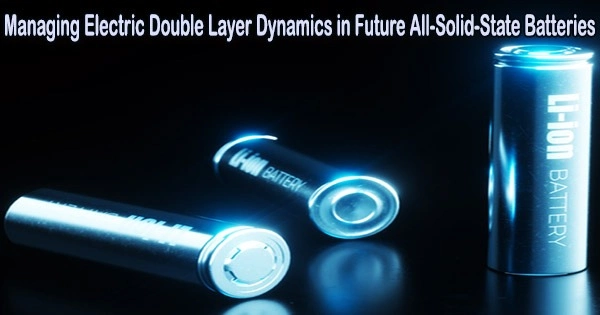To attain carbon neutrality, all-solid-state battery development is essential. These batteries’ low power, caused by their high surface resistance, restricts their use. In order to accomplish this, scientists have developed a revolutionary technique to analyze and control the dynamics of the electric double layer at the solid/solid electrolyte interface.
Researchers show unparalleled control of response speed by more than two orders of magnitude, which is a significant step toward the commercialization of all-solid-state batteries.
In our quest for clean energy and carbon neutrality, all-solid-state lithium-ion batteries (ASS-LIBs) offer considerable promise. Electric vehicles (EVs) are one of the many applications for which ASS-LIBs are anticipated to be deployed. Because of their high surface resistance, commercial use of these batteries is now constrained and their output is decreased.
Moreover, the exact mechanism of this surface resistance is hitherto unknown. Researchers have alluded it to a phenomenon called the “electric double layer” (or EDL) effect seen in colloidal substances (which are microscopic dispersions of one kind of particle in another substance).
The EDL effect happens when negatively charged ions from the dispersion medium adsorb on the surface of colloidal particles, giving them a negative electric charge.
“This occurs at the solid/solid electrolyte interface, posing a problem in all-solid-state lithium batteries,” explains Dr. Tohru Higuchi, Associate Professor at Tokyo University of Science (TUS). Dr. Higuchi, along with colleagues Dr. Makoto Takayanagi from TUS, Dr. Takashi Tsuchiya, and Dr. Kazuya Terabe from National Institute for Materials Science in Japan, has devised a novel technique to quantitatively evaluate the EDL effect at the solid/solid electrolyte interface.
The EDL has been shown to influence switching properties, so we considered that the switching response time for charging ASS-EDLs could be greatly improved by controlling the capacitance of the EDL. We used the non-ion-permeable property of diamond in the electron layer of the field-effect transistor and combined it with various lithium conductors.
Dr. Tohru Higuchi
An article detailing their technique was made available online on 8 February 2023 and was published in Volume 31 of Materials Today Physics. The researchers employed an all-solid-state hydrogen-terminated diamond (H-diamond)-based EDL transistor (EDLT) to conduct Hall measurements and pulse response measurements that determined EDL charging characteristics.
The team was able to study the electrical response of the EDL effect at the interface between these two layers by adding a nanometer-thick lithium niobate or lithium phosphate interlayer between the H-diamond and lithium solid electrolyte. The EDL effect was affected by the electrolyte’s composition in a tiny area at the electrode interface.
When a specific electrolyte was added as an interlayer between the electrode/solid electrolyte interface, the EDL impact was lessened. EDL capacitance for the lithium phosphate/H-diamond interface was much higher compared to the lithium niobate/H-diamond interface.
Additionally, they describe in their article how they increased the charging ASS-EDLs’ switching response time.
“The EDL has been shown to influence switching properties, so we considered that the switching response time for charging ASS-EDLs could be greatly improved by controlling the capacitance of the EDL. We used the non-ion-permeable property of diamond in the electron layer of the field-effect transistor and combined it with various lithium conductors,” Dr. Higuchi narrates.
The interlayer accelerated and decelerated the EDL charging speed. The electrical response time of the EDLT was highly variable it ranged from about 60 milliseconds (low-speed switching for lithium phosphate/H-diamond interface) to about 230 microseconds (high-speed switching for lithium niobate/H-diamond interface). However, the team showed two orders of magnitude of control over the EDL charging pace.
In conclusion, the researchers enhanced the charging properties of all-solid-state devices by achieving carrier modulation.
“These results from our research on the lithium-ion conductive layer are important for improving the interface resistance and may lead to the realization of all-solid-state batteries with excellent charge-discharge characteristics in the future,” notes an optimistic Dr. Higuchi.
When taken as a whole, this represents a significant advancement in the direction of reducing the interface resistance of ASS-LIBs, which facilitates their viability for a variety of applications. Additionally, it will aid in the improvement of solid-electrolyte-based devices, a category of technology that also incorporates neuromorphic gadgets.





